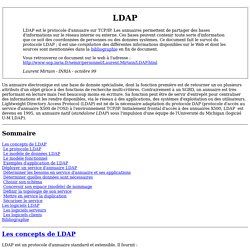

Migration slapd.conf to cn=config. Response Controls. Tutorial LDAP. Un annuaire électronique est une base de donnée spécialisée, dont la fonction première est de retourner un ou plusieurs attributs d'un objet grâce à des fonctions de recherche multi-critères.

Contrairement à un SGBD, un annuaire est très performant en lecture mais l'est beaucoup moins en écriture. Sa fonction peut être de servir d'entrepôt pour centraliser des informations et les rendre disponibles, via le réseau à des applications, des systèmes d'exploitation ou des utilisateurs. Lightweight Directory Access Protocol (LDAP) est né de la nécessaire adaptation du protocole DAP (protocole d'accès au service d'annuaire X500 de l'OSI) à l'environnement TCP/IP. Initialement frontal d'accès à des annuaires X500, LDAP est devenu en 1995, un annuaire natif (standalone LDAP) sous l'impulsion d'une équipe de l'Université du Michigan (logiciel U-M LDAP).
Sommaire Les concepts de LDAP Le protocole LDAP Le modèle de données LDAP Le modèle fonctionnel Exemples d'application de LDAP Choisir son schéma _ldap. Chapter 3 LDAP Schemas, ObjectClasses and Attributes. This Chapter is not for the faint-hearted.

It starts to drill down into the nauseous detail. You can either read it now or go to the Samples section and 'do stuff'. The samples have tons of links back to this chapter to explain specific items in detail. LDAP and X.500 are feet deep in terminology. Some terminology is important, some is just fluff. We have created a glossary to jog your memory and introduce terms, either because they are important or because they are frequently used in the literature. Because Schemas, objectClasses and Attributes are so interrelated, we use the highly technical term stuff to describe them collectively. Software 2.4 Administrator's Guide: Access Control. 8.1.

Introduction As the directory gets populated with more and more data of varying sensitivity, controlling the kinds of access granted to the directory becomes more and more critical. For instance, the directory may contain data of a confidential nature that you may need to protect by contract or by law. Or, if using the directory to control access to other services, inappropriate access to the directory may create avenues of attack to your sites security that result in devastating damage to your assets. Access to your directory can be configured via two methods, the first using The slapd Configuration File and the second using the slapd-config(5) format (Configuring slapd). The default access control policy is allow read by all clients. As a consequence, it's useless (and results in a performance penalty) to explicitly list the rootdn among the <by> clauses.
The following sections will describe Access Control Lists in greater depth and follow with some examples and recommendations. Software 2.4 Administrator's Guide: Access Control. 8.1.

Introduction As the directory gets populated with more and more data of varying sensitivity, controlling the kinds of access granted to the directory becomes more and more critical. For instance, the directory may contain data of a confidential nature that you may need to protect by contract or by law. Or, if using the directory to control access to other services, inappropriate access to the directory may create avenues of attack to your sites security that result in devastating damage to your assets.
Access to your directory can be configured via two methods, the first using The slapd Configuration File and the second using the slapd-config(5) format (Configuring slapd). Faq-O-Matic: Access Control.